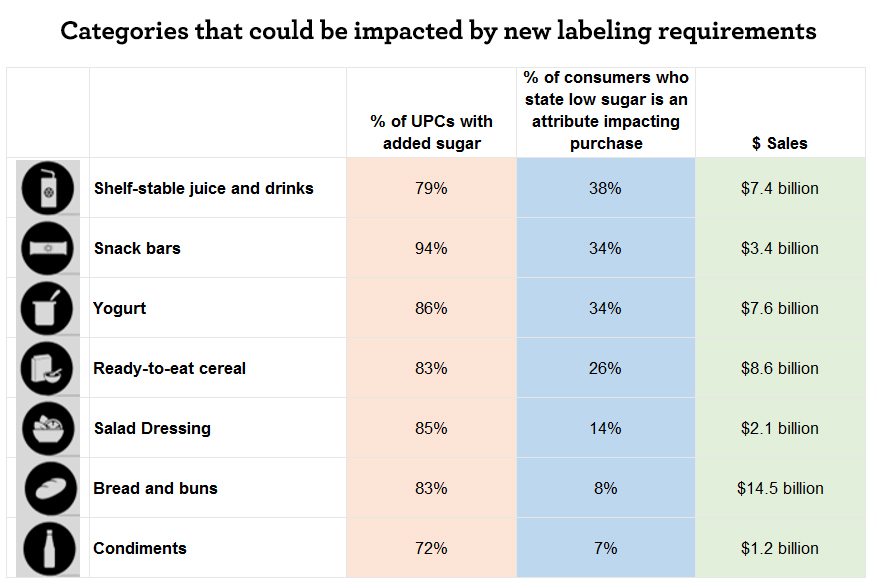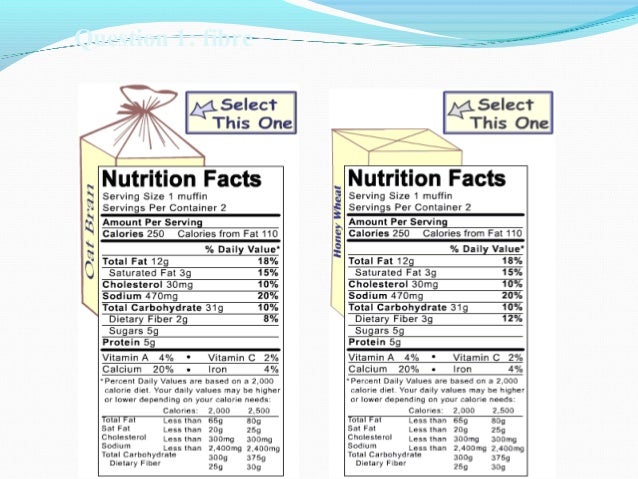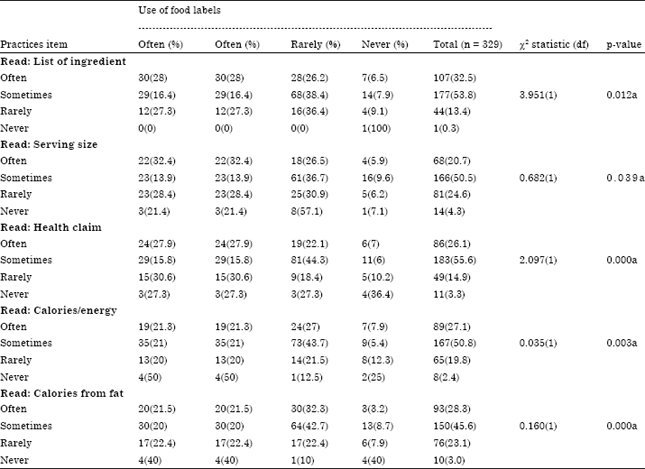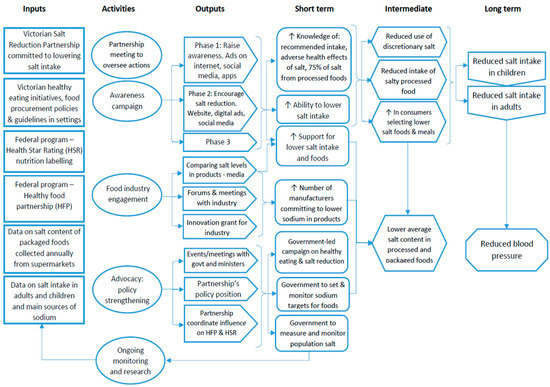43 analyze food labels for energy content
Analyze_Data_Explore_Per 2.docx - NAME DATE CLASS ... View Analyze_Data_Explore_Per 2.docx from SCIENCE 101 at Sunnyside High School. NAME DATE CLASS ANALYZING DATA Analyze Food Labels for Energy Content Most motor vehicles get the energy they need from The Science Behind Calories and Nutrition Facts Labels To measure the fat content in a food, the food is ground up and then mixed with a chemical that dissolves only the fat. ... Be careful, though. The measures of energy on labels tell you how much energy the food contains. It doesn't measure how much energy you can actually get from it. ... Chapter 2 - Analysis of edible oils and fats by ...
How to Understand and Use the Nutrition Facts Label | FDA Overview. The information in the main or top section (see #1-4) of the sample nutrition label (below) can vary with each food and beverage product; it contains product-specific information ...
Analyze food labels for energy content
How to Determine the Nutritional Value of Food - FoodCrumbles Besides that some other groups can contribute to the energy content: alcohols, polyols, fibre and organic acids. But in most foods the carbohydrates, proteins, fats and fibre take up most of the energy content. It has been defined by analysis how much energy one gram of these different groups of molecules will give to your body (the regulation ... How Do You Know Your Food's Nutrition Facts Label Is ... The short answer. Manufacturers often confirm their nutrition numbers by matching their products as closely as possible to NIST's food reference materials, which contain precisely measured quantities of nutrients. NIST's measurements are accurate to within 2% to 5% for nutrient elements (such as sodium, calcium and potassium ... Reading Food Labels (for Parents) - Nemours KidsHealth Percent daily value is most useful for seeing whether a food is high or low in nutrients: A food with 5% or less of a nutrient is low in that nutrient. A food with 10%-19% of a nutrient is a good source of that nutrient. A food with 20% or more of a nutrient is high in that nutrient. The information on food labels is based on an average diet ...
Analyze food labels for energy content. Nutrition information panels - Food Standards Nutrition information panels (NIP) on food labels provide information on the average quantity of energy in kilojoules or in kilojoules and kilocalories and these nutrients: sodium - a component of salt. A NIP will include information about other nutrients if a claim is made. For example, if a food has a 'good source of fibre' claim then the ... PDF Calorimetry: Measuring the Energy in Foods - Carolina.com 5. Calculate the energy content of the food in kilocalories/gram. 1.65 kcal/1.5 g = 1.1 kcal/g 6. Using information on the nutrition label of the food sample, calculate the food manufacturer's kilocalories/gram. (Divide calories per serving by the number of grams in a serving.) 90 Cal/ 38 g = 2.37 kilocal/gram 7. Investigating the Energy Content of Foods - Vernier Food supplies energy for all animals—without it we could not live. The quantity of energy stored in food is of great interest to humans. The energy your body needs for running, talking, and thinking comes from the foods you eat. Not all foods contain the same amount of energy, nor are all foods equally nutritious for you. An average person should consume a minimum of 2,000 kilocalories per ... How to understand food labels - Eat For Health Sometimes labels will include nutrition content claims like 'low fat', 'reduced salt' or 'high fibre'. These claims can only be used if the food meets certain criteria. For example, with a 'good source of calcium' claim, the food must contain more than a set amount of calcium. While nutrition content claims can generally guide ...
The Basics of the Nutrition Facts Label Step 4: Check Out the Nutrition Terms. Low calorie: 40 calories or less per serving. Low cholesterol: 20 milligrams or less and 2 grams or less of saturated fat per serving. Reduced: At least 25% less of the specified nutrient or calories than the usual product. Good source of: Provides at least 10 to 19% of the Daily Value of a particular ... Understanding food labels: portions, energy | Health24 When a food label states that the product contains 50cal and another product contains 50kcal, it actually means the same thing. Low-energy foods. Since so many people are trying to lose weight, it is important for them to understand which foods are low in energy. Generally speaking, a food that contains less than 170kJ per 100g or less than ... Energy labelling of alcoholic beverages Alcoholic beverages are exempt from the requirement to be labelled with a NIP containing energy content information unless a permitted nutrition content claim about energy or carbohydrate content is made. In August 2019, Ministers asked FSANZ to consider energy labelling of alcoholic beverages. Subsequently, in August 2020 Ministers endorsed ... Food Labels | Nutrition.gov What's New with the Nutrition Facts Label. HHS, Food and Drug Administration. The U.S. Food and Drug Administration (FDA) has updated the Nutrition Facts label on packaged foods and beverages with a fresh design that will make it easier for you to make informed food choices that contribute to lifelong healthy eating habits. What's in a Name?
Chapter 2: Methods of Food Analysis 3) Determination of available carbohydrate by difference is considered acceptable for purposes of energy evaluation for most foods, but not for novel foods or food for which a reduced energy content claim is to be made. In these cases, a standardized, direct analysis of available carbohydrate should be carried out. Nutrition labelling - Food Safety It must provide the energy value and the amounts of fat, saturates, carbohydrate, sugars, protein and salt of the food. The declaration must be presented in a legible tabular format on the packaging. Where space does not permit it, the information may be presented in linear format. This mandatory nutrition declaration is often provided on the ... Food Labels 101: Understanding the Nutrition Facts Label Nutrition labels can be a great tool for managing a heart healthy diet, which makes it very important that you understand what you're looking at when you read a label. Nutrition labels are based on a daily 2,000 calorie diet. Depending on your age, gender and activity level, you may need to consume more or less than 2,000 calories per day, so ... Food labels & nutritional information | Raising Children ... All foods have to list seven food components on their nutritional information panels - energy (kilojoules), protein, total fat, saturated fat, total carbohydrates, sugars and sodium. Manufacturers might decide to include other nutrients too, including fibre and calcium. Comparing the nutritional information on different food products helps ...
Food Labeling & Nutrition | FDA What's new in food labeling and nutrition, including label claims, nutrition labeling for restaurants, ... Content current as of: 03/25/2022. Regulated Product(s) Food & Beverages;
Food Labels (for Teens) - Nemours KidsHealth A food with 5% or less of a nutrient is low in that nutrient. A food with 10%-19% of a nutrient is a good source of that nutrient. A food with 20% or more of a nutrient is high in that nutrient. The information on food labels is based on an average adult diet of 2,000 calories per day. The actual number of calories and nutrients that kids ...
PDF Energy Content of Foods Your Name Lab Partners: Period ... The data showed that high fat foods have more energy than high sugar foods which was expected. The food with the highest energy content per gram was the peanut at 6186.4 J/g. The food with the lowest energy content per gram was the marshmallow at 362.3 J/g. This
Practical 1.3 - Investigate the energy content of food - BBC A simple investigation can be conducted to investigate the energy content of a food sample. Procedure. Add water - around 20cm 3 - to a boiling tube clamped in a retort stand.
Energy in Food and Nutrition | Chemistry for Non-Majors Energy from Protein: 5 g x 4 kcal/g = 20 kcal = 20 Cal. Convert to kJ. 20 Cal x 4.184kJ/Cal = 83.68 kJ = 84 kJ. Step 3: Think about your result . For the snack food in this example, most of the energy is coming from fat first, then from carbohydrates and finally from protein when these three sources of energy are considered. Summary. An example ...
Nutrition: Lesson 2 Nutrient & Food Label Facts 6) Minerals. Minerals are another nutrient category that, like vitamins, include a number of different forms. When we talk about minerals we are referring to calcium, iodide, phosphorous, fluorine, potassium, zinc and iron. Minerals help you have strong bones and teeth and healthy blood.
Nutrition labelling | Food Standards Agency When providing nutrition information, you are required to declare: energy value. amounts of fat, saturates, carbohydrate, sugars, protein and salt. The content of the mandatory nutrition declaration can be supplemented with an indication of the amounts of one or more of the following: monounsaturates. polyunsaturates.
How To Read Food and Beverage Labels | National Institute ... At the top of the Nutrition Facts label, you will find the total number of servings in the container and the food or beverage's serving size. The serving size on the label is based on the amount of food that people may typically eat at one time and is not a recommendation of how much to eat. Read more about serving and portion sizes.
Food labels: a guide to reading nutrition labels - MyDr.com.au Solid foods labelled as 'low-fat' must not contain more than 3 grams of fat per 100 gram; 'low-fat' liquid foods must not contain more than 1.5 grams of fat per 100 mL. Only foods that are low fat can use a fat-free claim. Labels can therefore only claim that a food is 97%, 98% or 99% fat free. 'Low cholesterol'.
Studying Food Labels Energy - Proper Nutrition ... Studying Food Labels Energy. July 31, 2020. 80 comments. Nutritionist Brittany. 10 min read. ... "Food labels seem to provide all the information a thoughtful consumer needs, so counting calories should be simple. ... Looking at food labels Food labels are an accessible source of information about the fat content of packaged foods.
Reading Food Labels (for Parents) - Nemours KidsHealth Percent daily value is most useful for seeing whether a food is high or low in nutrients: A food with 5% or less of a nutrient is low in that nutrient. A food with 10%-19% of a nutrient is a good source of that nutrient. A food with 20% or more of a nutrient is high in that nutrient. The information on food labels is based on an average diet ...
How Do You Know Your Food's Nutrition Facts Label Is ... The short answer. Manufacturers often confirm their nutrition numbers by matching their products as closely as possible to NIST's food reference materials, which contain precisely measured quantities of nutrients. NIST's measurements are accurate to within 2% to 5% for nutrient elements (such as sodium, calcium and potassium ...
How to Determine the Nutritional Value of Food - FoodCrumbles Besides that some other groups can contribute to the energy content: alcohols, polyols, fibre and organic acids. But in most foods the carbohydrates, proteins, fats and fibre take up most of the energy content. It has been defined by analysis how much energy one gram of these different groups of molecules will give to your body (the regulation ...















Post a Comment for "43 analyze food labels for energy content"